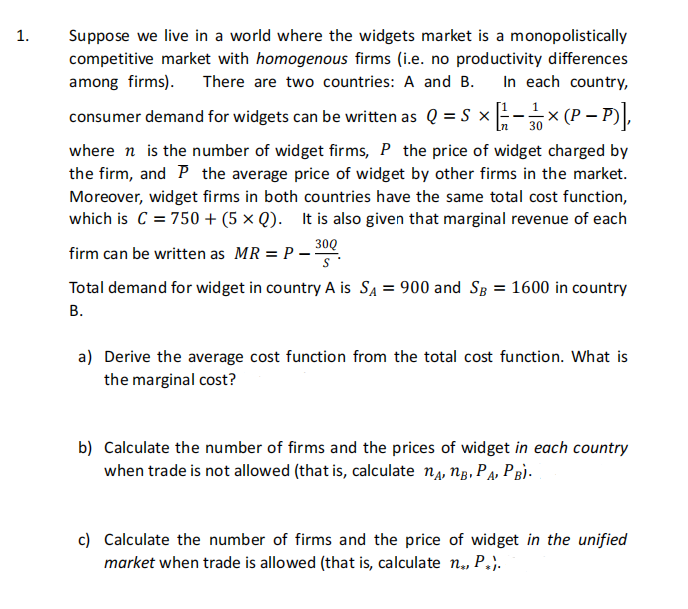1. Suppose we live in a world where the widgets market is a monopolistically competitive market with homogenous firms (i.e. no productivity differences among firms). There are two countries: A and B. In each country, consumer demand for widgets can be written as Q = S x-x (P – P), where n is the number of widget firms, P the price of widget charged by the firm, and P the average price of widget by other firms in the market. Moreover, widget firms in both countries have the same total cost function, which is C = 750 + (5 × Q). It is also given that marginal revenue of each firm can be written as MR = P – 300 Total demand for widget in country A is SA = 900 and Sg = 1600 in country %3D
1. Suppose we live in a world where the widgets market is a monopolistically competitive market with homogenous firms (i.e. no productivity differences among firms). There are two countries: A and B. In each country, consumer demand for widgets can be written as Q = S x-x (P – P), where n is the number of widget firms, P the price of widget charged by the firm, and P the average price of widget by other firms in the market. Moreover, widget firms in both countries have the same total cost function, which is C = 750 + (5 × Q). It is also given that marginal revenue of each firm can be written as MR = P – 300 Total demand for widget in country A is SA = 900 and Sg = 1600 in country %3D
Chapter10: Monopolistic Competition And Oligopoly
Section: Chapter Questions
Problem 1.2P
Related questions
Question

Transcribed Image Text:1.
Suppose we live in a world where the widgets market is a monopolistically
competitive market with homogenous firms (i.e. no productivity differences
among firms). There are two countries: A and B.
In each country,
consumer demand for widgets can be written as Q = S x- x (P – P),
30
where n is the number of widget firms, P the price of widget charged by
the firm, and P the average price of widget by other firms in the market.
Moreover, widget firms in both countries have the same total cost function,
which is C = 750 + (5 × Q). It is also given that marginal revenue of each
30Q
firm can be written as MR = P –
Total demand for widget in country A is SA = 900 and Sg = 1600 in country
В.
a) Derive the average cost function from the total cost function. What is
the marginal cost?
b) Calculate the number of firms and the prices of widget in each country
when trade is not allowed (that is, calculate na, ng, Pa, PBÌ-
c) Calculate the number of firms and the price of widget in the unified
market when trade is allowed (that is, calculate n,, P.}.
Expert Solution
This question has been solved!
Explore an expertly crafted, step-by-step solution for a thorough understanding of key concepts.
This is a popular solution!
Trending now
This is a popular solution!
Step by step
Solved in 3 steps

Knowledge Booster
Learn more about
Need a deep-dive on the concept behind this application? Look no further. Learn more about this topic, economics and related others by exploring similar questions and additional content below.Recommended textbooks for you


Principles of Economics (MindTap Course List)
Economics
ISBN:
9781305585126
Author:
N. Gregory Mankiw
Publisher:
Cengage Learning

Principles of Microeconomics (MindTap Course List)
Economics
ISBN:
9781305971493
Author:
N. Gregory Mankiw
Publisher:
Cengage Learning


Principles of Economics (MindTap Course List)
Economics
ISBN:
9781305585126
Author:
N. Gregory Mankiw
Publisher:
Cengage Learning

Principles of Microeconomics (MindTap Course List)
Economics
ISBN:
9781305971493
Author:
N. Gregory Mankiw
Publisher:
Cengage Learning

Principles of Economics, 7th Edition (MindTap Cou…
Economics
ISBN:
9781285165875
Author:
N. Gregory Mankiw
Publisher:
Cengage Learning

Principles of Microeconomics
Economics
ISBN:
9781305156050
Author:
N. Gregory Mankiw
Publisher:
Cengage Learning
